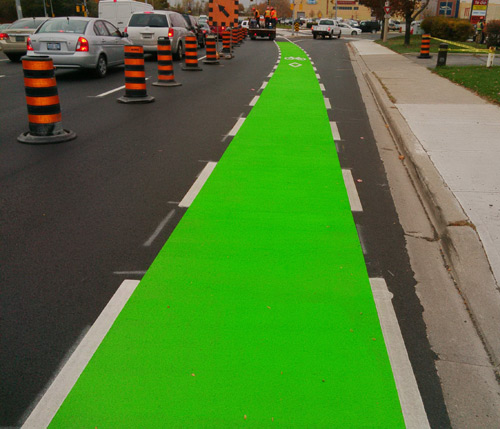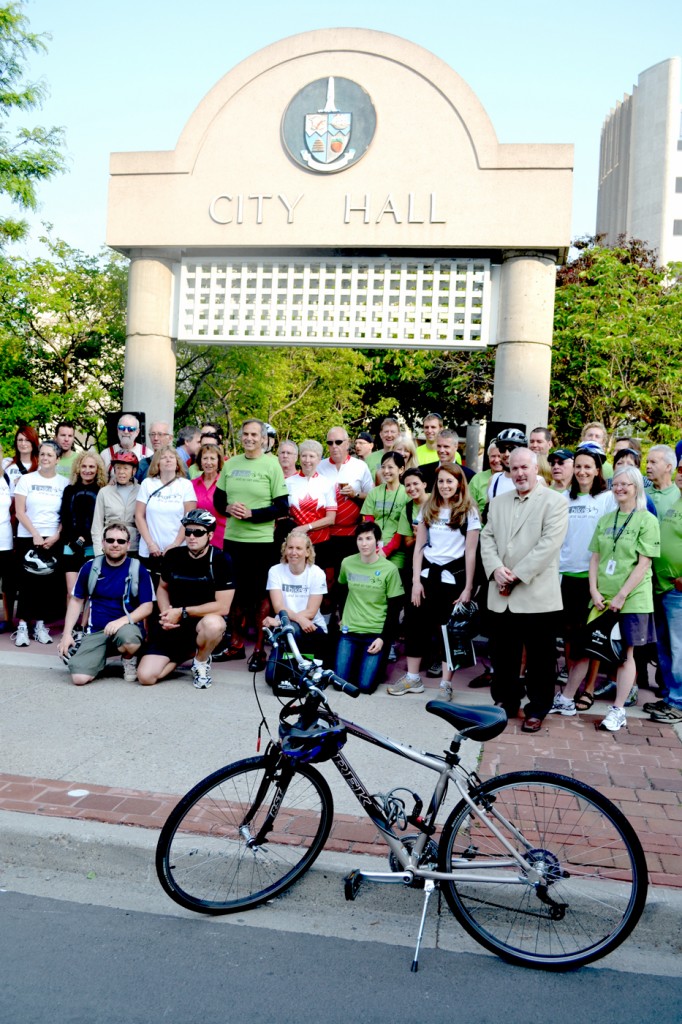 By Connor Fraser
By Connor Fraser
June 8th, 2022
BURLINGTON, ON
A significant portion of my life has been spent cycling around Burlington. During high school, my commute often took me along Plains Road. On weekends, my friends and I would find our way to Spencer Smith Park and the beach. From a young person’s perspective, safe cycling options go a long way towards cementing a lifelong commitment to healthy behaviour.

Lanes dedicated to cycling – some want to see barriers in place to protect cyclists.
If my experience has taught me one thing, it’s that travelling around Burlington on a bicycle is inconvenient and borderline dangerous. Bike lanes along major streets such as Plains Road are intermittent and full of potholes. Connecting lanes between neighbourhoods – such as the Lakeshore Road QEW underpass – are non-existent. Under such conditions, cyclists are forced to dismount and walk long distances, or take their chances in live traffic.
Thankfully, a number of large-scale cycling projects are about to break ground in Burlington. In 2022, Plains Road between Waterdown Road and Spring Gardens Road will be resurfaced and buttoned up with protected cycling facilities. In 2025, Prospect Street and the remainder of Plains Road are scheduled for installations.
While these projects are likely to cause short-term disruptions to residents’ lifestyles, they should be welcomed with enthusiasm and open-mindedness. Aligning near-perfectly with the city’s strategic goals, cycling is both an environmentally sustainable method of transportation, and one that promotes long-term physical and mental health. As much as bike lanes are a short-term investment to enable diverse forms of mobility, they are also a long-term investment in environmental health and preventative healthcare. People who are empowered to cycle more often due to the presence of a convenient cycling network are more likely to remain healthy and happy throughout their lives.

City photo op to promote cycling to work. Several very senior people in this picture even owned a bike.
Unfortunately, Burlington’s recent past has been marred with hostility towards the concept of bike lanes. The New Street Bike Lane Pilot was removed in 2018 following the recommendations of a report entitled “New Street pilot project review and resurfacing.” While the report noted a common perception among residents that traffic along New Street became more congested during the pilot, the authors admitted that cause and effect was difficult to determine. For example, average westbound travel times between Walkers Line and Guelph Line increased by just 1.5 minutes during peak evening hours, while negligible travel time increases were noted for eastbound travel during peak hours. Moreover, when taking an average of datapoints over the entire day, impacts to travel times were minimal in both directions (+16 seconds westbound, +1 second eastbound). The report also found inconclusive evidence of traffic diversion onto adjacent roadways. Nevertheless, the New Street pilot was removed by council, setting back Burlington’s progress towards integrated mobility by several years.
Fast forward to the present, and conditions have changed such that all residents should be able to embrace, and also benefit from, upcoming cycling installations. Notably, the pandemic has enabled more people to work from home and avoid rush-hour traffic that some claim is aggravated by bike lanes.
Despite my above enthusiasm, progress towards building out the municipal cycling network is slow and suffers from critical underfunding. The New Street pilot project review and resurfacing report recommended (as a consolation) installing separated cycle tracks “for consideration in the 2019 to 2028 capital budget.” My sources at city hall informed me this project has been pushed until 2031 – a delay of at least 3 years. According to the 2022 Budget, several other projects that were listed as “high priority” by the 2021 Cycling Plan and initially targeted for completion by 2025 – have subsequently been pushed back. The Active Transportation Crossing of the QEW and Walker’s Line resurfacing will be delayed by 5-6 years and 2-3 years respectively beyond original timelines, documents suggest. We’ll see if anything changes once the Integrated Mobility Plan is released.
Is Burlington under equipped to make investments in public infrastructure and in particular cycling infrastructure? The media release page for the 2022 budget proudly displays how our municipal tax rate is significantly lower than other GTA municipalities (over 12.5% lower than the average municipality). If the consequence is that important projects must experience significant delays, it’s not a statistic to be proud of. We must be willing to pay for infrastructure upgrades, especially those that enhance quality of life to the extent that bike lanes will. Not only could there be noticeable upsides for property values (transit oriented communities are actually desirable for young people and young families), but the long term returns to personal, public and environmental health would be material and far outweigh any initial investment. One might argue that the above-cited delays are pandemic-related. However, our neighbours such as the City of Toronto used the pandemic as a catalyst for major expansions of their cycling networks.
The point is this. From my limited understanding, life is about compromise. That’s precisely what is happening here and why I hope to see uniform support behind city council and city staff. On one hand, Burlington is getting new cycling infrastructure. On the other hand, the projects have been delayed and will likely be completed incrementally over the next decade – keeping impacts on daily routines to an absolute minimum and allowing long periods for adjustment. Compromise.
I sincerely hope that most are enthusiastic about the upcoming cycling projects and are ready to eventually consider embracing cycling as a legitimate alternative to the automobile when it comes to getting around town!
 Connor was born in Hamilton in 1997, is a long-time resident of Aldershot. He has volunteered for several local organizations and advocated to municipal leaders on building transit oriented, walkable communities.
Connor was born in Hamilton in 1997, is a long-time resident of Aldershot. He has volunteered for several local organizations and advocated to municipal leaders on building transit oriented, walkable communities.
In 2020, Connor completed undergraduate studies at the University of Toronto, with a B.A.Sc. in Engineering Science and a major in Electrical and Computer Engineering.
Connor has returned to U of T to enrol in the dual Master of Global Affairs and Master of Business Administration program.

















Connor. I drove on New Street daily at different times of the day and can honestly say I never saw one cyclist using the bike lanes when we had the pilot project. I would be curious to know how many cyclists you found in your research that used these bike lanes.
“We must be willing to pay for infrastructure upgrades, especially those that enhance quality of life to the extent that bike lanes will.”
Tell you what Connor: before we start green-lighting tax increases on already overburdened and overtaxed residents let’s ensure that the existing tax revenues are being spent wisely. Rainbow sidewalks, multiple speed bumps on roads, public art programs, EDI initiatives, etc., don’t meet the threshold of what I would consider prudent spending.
As for cyclists, if they want to ride then be my guest. No one is stopping them. However, as Hans and Jim have very astutely pointed out, cycling in winter is dangerous half the year due to inclement weather conditions. Cyclists are also their own worst enemy, and continue to take unnecessary risks (e.g. Idaho stops, no hand signalling, riding abreast) which compromise their personal safety.
If I have to sustain a tax increase I’d rather it went into sidewalk repairs, park maintenance and upgrades to existing infrastructure that will benefit all residents, not just the handful of pet projects routinely propagated by Advisory groups (a.k.a. Advocacy Groups) at City Hall.
Without a physical barrier bike lanes are nearly useless. I’ve been riding a bike in Burlington since the 70s. Traffic has increased to the point where it is hazardous to ride a bike. It goes both ways. I’ve encountered cyclists, in all their gear, riding 3 a breast blocking traffic. Almost taunting drivers to honk so they cab give the 1 finger salute. Definitely not sharing the road.
As a motorist I am always aware of the potential danger to both the motorist and the cyclist. The bicycle lanes are not safe. When bicycle lanes are constructed on existing streets, the motorist lanes are made smaller. Worse are the “Sharrows” ( share the road signs) as it is difficult for both the motorist and cyclist to manoeuvre .
When speaking to members of the Cycling Committee a few years ago I mentioned that the dedicated lanes should be large enough to accommodate 3 wheeled cycles ( many seniors cannot balance on a regular bicycle) and this could include mobility scooters. This was like an “aha” moment for them.
Not enough thought is put into deciding where these bicycle lanes go and could be a disaster waiting to happen.
Painting them green doesn’t make a difference if as discussed in the article the lane comes to an abrupt end.
Try negotiating around the city on a mobility scooter as many of our seniors have to. That is downright dangerous too. Plus our city has chosen to also leave them without charging spots meaning they have to go back home before they run out of power. Charging spots for those who utilize mobility scooters to serve their mobility disability needs is a human rights requirement whereas providing three ele tric charging stations for cars in the city hall parking spots is not. We have been addressing this for years Conner. Perhaps our elected councillors hearing it from a young journalist like yourself may make a difference that would be extremely appreciated. Oh yes, we forgot cyclists can sit on their biles leaning on the pier rails and enjoy the stunning views not so for mobility scooter users who also cannot stand. All they see is the rails. We are looking to raise the issue of an indoor bike park for the enjoyment of families similar to Joy Ride for the winter bike fanatics who want to stay fit and a couple of outdoor pump tracks when the city gets around to discussing an updated recreation plan.
Canadian towns and cities were built typically without planning for bicycles. Effective retrofitting of cycling infrastructure is very difficult, expensive, – especially when the seasonal nature of cycling is considered – and typically results in a zero-sum game; i.e., where cycling’s gain is motorists’ loss. It should not be attempted in haste, but included in a comprehensive plan for a city’s entire transportation system.
As a rider I find it telling that we get nothing but political speak on how everything is getting better, not sure where. I once asked a Councilor if he rode a bike to City hall, which was a couple of K’s away from his house, he laughed !! This is the type of person overseeing these changes.
As a regular user of most intercity roads, I find it interesting that over the last couple of years they have eliminated bike lanes on some City streets. They don’t repair sunken storm sewer grates in bike lanes, don’t force contractors who rip up the streets to bring them back to original condition. They install speed bumps beside storm sewers and it becomes a race to see if a car can drive you into the sunken sewer so they can avoid the yellow marker in the middle of the road.
Also driver education as to what 3 feet distance away really is, some of the worst offenders are City buses, they maybe 3 feet away, but forget the 2 feet of mirror hanging off the side, this is the same with many commercial vehicles. The City allows landscape contractor to park in No Parking zones by simply putting out some orange cones, forcing riders into live lanes.
Paved bike paths allow groups of walkers and bikers that go 50k, but a lower speed restricted electric bike/mobility devise is a no no.
Great article Connor. Let’s hope some of the City’s decision makers read it and learn. Living in the rural part of Burlington, we find it too dangerous to ride our bikes along our roads. Hopefully sometime in the future we will have dedicated bike lanes along the City roads, the Region roads, Appleby and Guelph, already have bike lanes.
When the climate warms up then cycling will become a legitimate alternative to the automobile.
Cycling in snow and ice is hazardous.